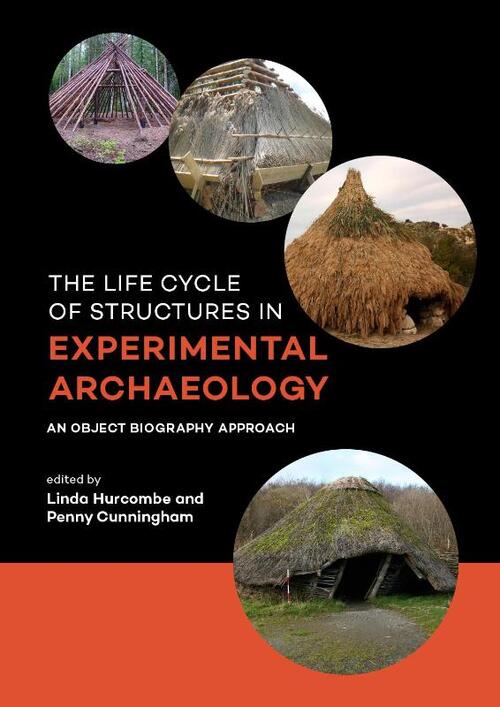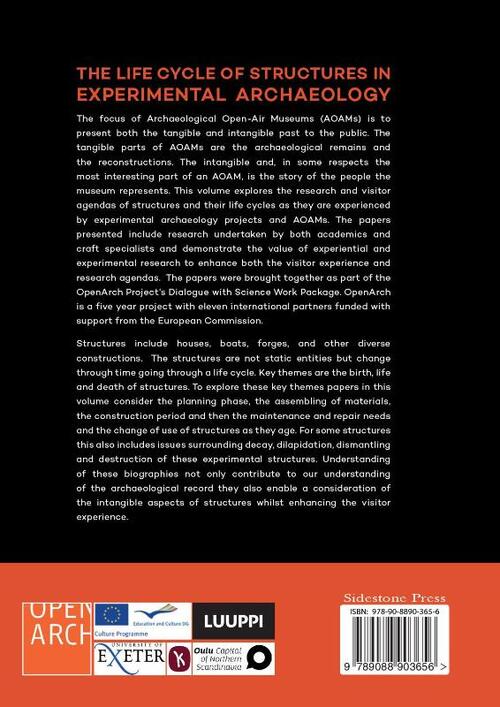120.00
1 - 2 Weken
The focus of Archaeological Open-Air Museums (AOAMs) is to present both the tangible and intangible past to the public. The tangible parts of AOAMs are the archaeological remains and the reconstructions. The intangible and, in some respects the most interesting part of an AOAM, is the story of the people the museum represents. This volume explores the research and visitor agendas of structures and their life cycles as they are experienced by experimental archaeology projects and AOAMs. The papers presented include research undertaken by both academics and craft specialists and demonstrate the value of experiential and experimental research to enhance both the visitor experience and research agendas. The papers were brought together as part of the OpenArch Project's Dialogue with Science Work Package. OpenArch is a five year project with eleven international partners funded with support from the European Commission.
Structures include houses, boats, forges, and other diverse constructions. The structures are not static entities but change through time going through a life cycle. Key themes are the birth, life and death of structures. To explore these key themes papers in this volume consider the planning phase, the assembling of materials, the construction period and then the maintenance and repair needs and the change of use of structures as they age. For some structures this also includes issues surrounding decay, dilapidation, dismantling and destruction of these experimental structures. Understanding of these biographies not only contribute to our understanding of the archaeological record they also enable a consideration of the intangible aspects of structures whilst enhancing the visitor experience.
Contents
Preface
Penny Cunningham, Linda Hurcombe, and Leena Lehtinen
1 Introduction: The object biography approach to structures
Linda Hurcombe & Penny Cunningham
Planning Structures
2 Hands on Heritage: experimental and experiential archaeology in the Avalon Marshes, Somerset, UK.
Richard Brunning
3 "U Pagghiaru": studies of traditional shepherd's huts and their relevance to a Bronze Age hut-rebuilding project in Sicily
Kati Caruso and Claudia Speciale
Thinking through structures
4 Plant materials, hides and skins as structural components: perishable material culture and archaeological invisibility
Theresa Emmerich Kamper and Linda Hurcombe
5 Saving it for later: gathering, processing and food storage structures
Penny Cunningham
6 Boats as structures
Linda Hurcombe & Brian Cumby
7 Experiments on possible Stone Age glue types
Werner Pfeifer
Construction
8 Experiences of thatching at Kierikki Stone Age Village, Finland
Inga Nieminen
9 A gateway to the Bronze Age: Experimenting with woodworking methods of the Terramara culture in Montale in Italy
Wolfgang Lobisser
10 "From Earth I Rose" Experimenting stone slab furnaces of the Finnish Early Iron Age
Joni-Pekka Karjalainen and Juuso Vattulainen
11 Polvus eris et in polvus reverteris: Experimental production of Iberian iron and post-processing approach to the furnace structures
José Miguel Gallego Cañamero, Manel Gómez Gutiérrez and Josep Pou I Vallès
Structures
12 Testing the indoor environment and personal health in an inhabited reconstructed Viking Age house during winter
Jannie Marie Christensen
13 Experiences concerning Stone age building constructions in Finland
Eero Muurimäki
Decline of structures
14 Blackhand Kiva: biography of a replica ancestral Pueblo subterranean masonry-lined structure, Montezuma Coun
Structures include houses, boats, forges, and other diverse constructions. The structures are not static entities but change through time going through a life cycle. Key themes are the birth, life and death of structures. To explore these key themes papers in this volume consider the planning phase, the assembling of materials, the construction period and then the maintenance and repair needs and the change of use of structures as they age. For some structures this also includes issues surrounding decay, dilapidation, dismantling and destruction of these experimental structures. Understanding of these biographies not only contribute to our understanding of the archaeological record they also enable a consideration of the intangible aspects of structures whilst enhancing the visitor experience.
Contents
Preface
Penny Cunningham, Linda Hurcombe, and Leena Lehtinen
1 Introduction: The object biography approach to structures
Linda Hurcombe & Penny Cunningham
Planning Structures
2 Hands on Heritage: experimental and experiential archaeology in the Avalon Marshes, Somerset, UK.
Richard Brunning
3 "U Pagghiaru": studies of traditional shepherd's huts and their relevance to a Bronze Age hut-rebuilding project in Sicily
Kati Caruso and Claudia Speciale
Thinking through structures
4 Plant materials, hides and skins as structural components: perishable material culture and archaeological invisibility
Theresa Emmerich Kamper and Linda Hurcombe
5 Saving it for later: gathering, processing and food storage structures
Penny Cunningham
6 Boats as structures
Linda Hurcombe & Brian Cumby
7 Experiments on possible Stone Age glue types
Werner Pfeifer
Construction
8 Experiences of thatching at Kierikki Stone Age Village, Finland
Inga Nieminen
9 A gateway to the Bronze Age: Experimenting with woodworking methods of the Terramara culture in Montale in Italy
Wolfgang Lobisser
10 "From Earth I Rose" Experimenting stone slab furnaces of the Finnish Early Iron Age
Joni-Pekka Karjalainen and Juuso Vattulainen
11 Polvus eris et in polvus reverteris: Experimental production of Iberian iron and post-processing approach to the furnace structures
José Miguel Gallego Cañamero, Manel Gómez Gutiérrez and Josep Pou I Vallès
Structures
12 Testing the indoor environment and personal health in an inhabited reconstructed Viking Age house during winter
Jannie Marie Christensen
13 Experiences concerning Stone age building constructions in Finland
Eero Muurimäki
Decline of structures
14 Blackhand Kiva: biography of a replica ancestral Pueblo subterranean masonry-lined structure, Montezuma Coun

- : Sidestone Press
- : Sidestone Press
- : 9789088903892
- : Engels
- : Hardcover
- : 180
- : oktober 2016
- : 823
- : 265 x 188 x 19 mm.

